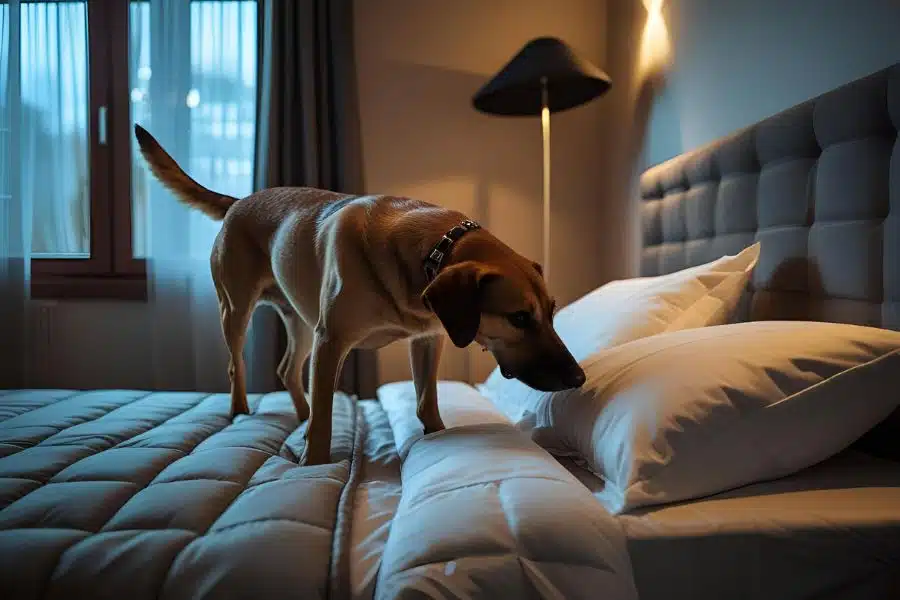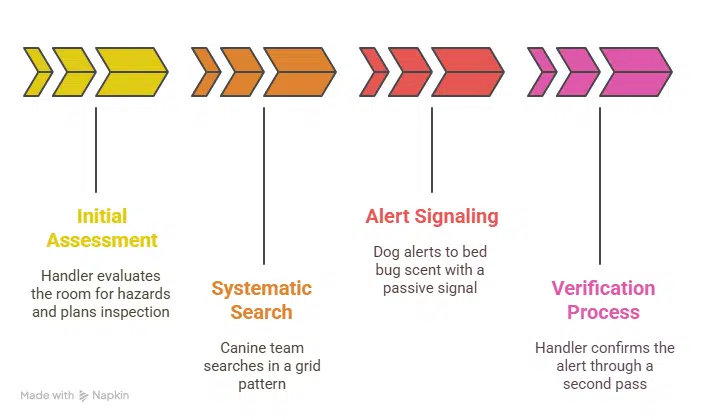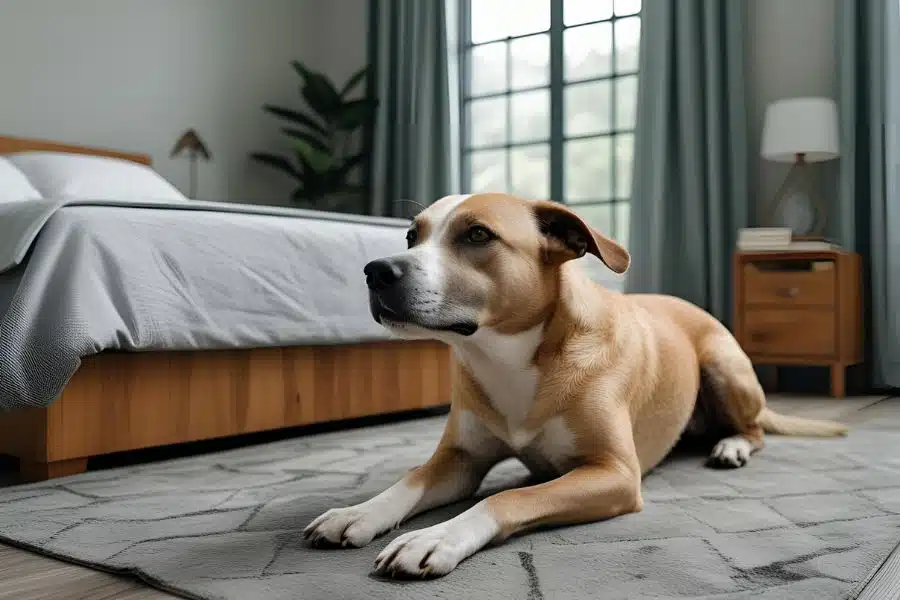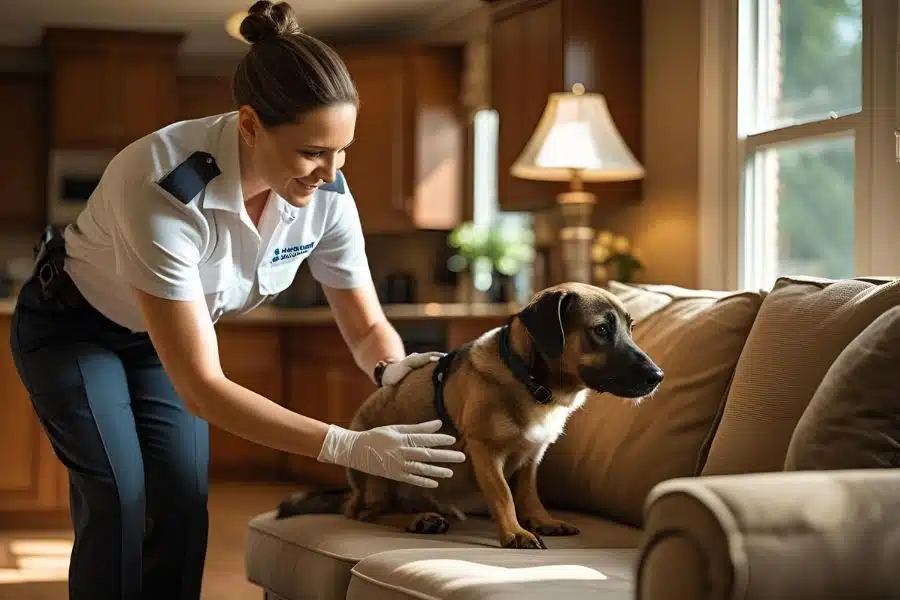Bed bugs are a growing concern for property owners around the world. These sneaky pests can hide in the smallest spaces, making it difficult for even the most skilled pest control experts to find them. Traditional methods of checking for bed bugs often miss early infestations, allowing these unwanted creatures to breed quickly and spread throughout buildings.
But there’s a new solution that is changing the game: bed bug sniffing dogs. These specially trained dogs have transformed pest detection with their incredible ability to find bed bugs at any stage of their life cycle. Their sharp sense of smell can pick up these pests through walls, furniture, and other hiding places that humans can’t see.
Table of Contents
The increasing need for Bed Bug detection services is evident in various industries:
- Hotels wanting to maintain their reputation and ensure a pleasant experience for guests
- Residential properties seeking peace of mind
- Commercial buildings needing regular inspections
- Healthcare facilities upholding strict cleanliness standards
Property owners are turning to these four-legged inspectors more and more for their unmatched precision and effectiveness. A certified bed bug detection dog can thoroughly search an average-sized home in less than 30 minutes, providing instant results without having to move furniture or disturb residents. This non-invasive method, combined with detection rates over 95%, makes K9 inspection services an appealing choice for anyone serious about preventing and controlling bed bugs.
Understanding Bed Bug Sniffing Dogs

Bed bug sniffing dogs are a specialized type of scent detection dog trained specifically to find bed bug infestations. These highly skilled canines use their exceptional sense of smell to locate live bed bugs and viable eggs hidden in places like walls, furniture, and other areas that humans might overlook.
Key Capabilities of K9 Bed Bug Detection:
- Detect bed bugs through mattresses, wall voids, and furniture
- Identify infestations in early stages before visible signs appear
- Pinpoint exact locations of bed bug activity
- Search multiple rooms quickly and efficiently
Limitations of Traditional Inspections
Traditional visual inspections rely on human technicians searching for physical evidence like shed skins, fecal matter, or live bugs. This method proves time-consuming and often misses early-stage infestations hidden in hard-to-reach areas.
Advantages of K9 Bed Bug Detection
A trained bed bug detection dog can search an average-sized room in 2-3 minutes with remarkable precision. Their noses can distinguish between live bed bugs and other insects, eliminating false positives from similar pests. This targeted approach helps property owners save money by focusing treatment efforts on confirmed infestation sites.
The bed bug sniffing dog cost typically ranges from $250-$500 per inspection, varying by property size and location. This investment often proves cost-effective by enabling early detection and preventing widespread infestations that require extensive treatment.
The Science Behind K9 Bed Bug Detection
A dog’s nose contains approximately 300 million olfactory receptors, compared to a human’s mere 6 million. This remarkable biological difference enables bed bug dog scent detection with pinpoint accuracy. The canine olfactory system can identify the specific pheromones and kairomones released by bed bugs at concentrations as low as one part per trillion.
A typical bed bug dog inspection follows these precise steps:

- Initial Assessment: The bed bug dog handler conducts a brief room evaluation to identify potential hazards and establish an inspection pattern
- Systematic Search: The canine team methodically works through the space in a grid pattern, focusing on common bed bug hiding spots
- Alert Signaling: When detecting bed bug scent, trained dogs provide a specific passive alert—typically sitting or pointing at the exact location
- Verification Process: The handler confirms the dog’s alert through a second pass of the area to ensure accuracy
The scientific basis for this detection method lies in the dog’s ability to differentiate between live bed bugs and other insects through their unique scent signature. Research shows bed bug canine teams can detect infestations through walls, inside electrical outlets, and within furniture seams—areas traditionally challenging for human inspectors to access.
The handler’s expertise in reading their dog’s subtle behavioral changes adds another layer of scientific precision to the inspection process. This partnership creates a sophisticated detection system that combines canine biology with human analytical skills.
Training and Certifying Bed Bug Sniffing Dogs
The journey from an ordinary dog to a certified bed bug detection expert involves intensive training that shapes both the dog’s natural abilities and working relationship with its handler. Professional K9 bed bug detection units undergo a rigorous six to eight-week training program that includes:
1. Scent Recognition Training
- Introduction to live bed bug samples
- Differentiation between dead and alive specimens
- Learning to identify eggs and various life stages
2. Search Pattern Development
- Systematic room scanning techniques
- Wall-to-wall inspection methods
- Furniture and fixture examination protocols
3. Handler-Dog Communication
- Alert signal establishment
- Reward timing precision
- Command response refinement
The National Entomology Scent Detection Canine Association (NESDCA) certification process validates these skills through demanding practical tests. Certified bed bug sniffing dogs must demonstrate:
- 95% accuracy in controlled environments
- Zero false positives during testing
- Consistent alert signals
- Professional behavior standards
Certification renewal requirements keep K9 teams sharp, with mandatory annual testing and continuing education. Top bed bug dog training facilities maintain relationships with pest control companies to ensure their graduates work with real infestations under varied conditions. This practical experience strengthens the dog’s detection abilities and builds handler confidence in real-world scenarios.
Evaluating the Accuracy and Effectiveness of Bed Bug Sniffing Dogs

Research studies consistently demonstrate the superior detection capabilities of certified bed bug sniffing dogs compared to human visual inspections. While human inspectors typically achieve a 30-40% detection rate, certified canine teams boast an impressive 95% accuracy rate in identifying bed bug infestations.
Why Are Bed Bug Dogs So Effective?
The effectiveness of bed bug dogs stems from their ability to:
- Detect live bugs and viable eggs through walls and furniture
- Pinpoint exact infestation locations within minutes
- Identify bed bugs at all life stages
- Cover large areas efficiently
When Can Bed Bug Dogs Make Mistakes?
Bed bug dog false positives can occur under specific circumstances:
- Environmental factors: Strong odors, chemical residues, or recent pesticide treatments
- Handler inexperience: Misreading dog signals or improper guidance
- Physical conditions: Extreme temperatures or high humidity levels
- Dog fatigue: Extended working periods without adequate breaks
The Importance of Handler-Dog Collaboration
The accuracy rate depends heavily on the synergy between handler and canine. Experienced handlers maintain consistent working patterns, recognize their dog’s subtle behavioral changes, and understand when environmental conditions might affect performance.
Continuous Improvement Through Training and Testing
Regular field testing and continuous training help maintain high detection standards. Many professional services employ multiple dogs to cross-verify findings, reducing the likelihood of missed infestations or false alerts.
The Non-Invasive Advantage: How Bed Bug Dogs Conduct Inspections
A bed bug dog inspection process stands out for its gentle, non-destructive approach to pest detection. Unlike traditional inspection methods that require dismantling bed frames, removing mattresses, or pulling apart furniture, these trained canines can detect bed bugs without disturbing your living space.
Inspection Process Breakdown:
- Dogs systematically sweep rooms by following a structured search pattern
- Handlers guide their canines along baseboards, furniture edges, and potential hiding spots
- When a dog detects bed bugs, it signals through a specific trained behavior like sitting or pawing
- The entire process maintains the integrity of furniture and room fixtures
Time Requirements by Property Type:
- Residential Homes: 15-30 minutes for a typical bedroom
- Hotel Rooms: 2-5 minutes per room for routine screening
- Commercial Properties: 1-2 hours for standard office spaces
The non-invasive inspection approach proves particularly valuable in sensitive environments like hotels, where maintaining room presentation is crucial. These inspections can occur during regular business hours without disrupting operations or requiring room closures.
A bed bug dog non-invasive inspection also reduces stress for property owners who fear potential damage to expensive furnishings or antique pieces during traditional inspections. This method preserves the condition of inspected areas while delivering accurate results, making it an increasingly popular choice for property managers and homeowners alike.
Exploring Common Bed Bug Dog Breeds Used in Detection Work
Certain dog breeds are particularly skilled at finding bed bugs because of their natural hunting instincts and excellent sense of smell.
Beagles: Top Performers in Bed Bug Detection
Beagles are known for their outstanding abilities in detecting bed bugs. Here are some reasons why they excel in this field:
- Their compact size allows them to access tight spaces where bed bugs often hide.
- Being natural hunters, Beagles have enhanced tracking abilities that help them locate bed bugs effectively.
- Their strong food drive motivates them during intensive training sessions.
- With a gentle temperament, Beagles are well-suited for conducting inspections in residential areas without causing disturbance.
Also Read: Sniffer Dog Training: how to train your dog to be a sniffer dog?
Labrador Retrievers: Unique Advantages in Detection Work
Labrador Retrievers also bring unique advantages to bed bug detection work. Here’s how they contribute:
- Known for their high intelligence, Labradors can understand and follow complex search patterns set by their handlers.
- Their strong work ethic ensures that they conduct thorough inspections, leaving no corner unchecked.
- With excellent stamina, Labradors can cover large commercial properties efficiently during inspections.
- Being adaptable by nature, Labradors can handle varied environments such as hotels, offices, or homes where bed bug infestations may occur.
Other Effective Breeds in Bed Bug Detection
In addition to Beagles and Labrador Retrievers, there are other dog breeds that have proven to be effective in detecting bed bugs:
- Belgian Malinois
- German Shepherds
- Jack Russell Terriers
The success of each breed in bed bug detection depends on several factors:
- Individual traits specific to each breed
- Proper training techniques employed
- The expertise of the handler working with the dog
To ensure optimal results, these working dogs undergo specialized pheromone detection training. This training equips them with the ability to identify bed bugs at all stages of their life cycle—eggs, nymphs, and adults—making them invaluable assets in both preventative detection efforts and treatment follow-up programs.
Practical Applications and Cost Considerations of Using Bed Bug Sniffing Dogs Across Different Environments
The versatility of bed bug detection dogs shines across diverse settings, each with unique inspection requirements and challenges.
1. Hotels and Hospitality Settings
Bed bug dogs for hotels provide critical rapid-screening capabilities:
- Inspect up to 60 rooms per day
- Minimize guest disruption during checks
- Identify potential issues before guest complaints
- Target specific rooms for treatment
- Reduce unnecessary chemical treatments
2. Residential Properties
Home inspections with bed bug dogs offer distinct advantages:
- Complete house screening in 1-2 hours
- Pinpoint exact infestation locations
- Early detection prevents spread between rooms
- Non-destructive inspection methods preserve furniture
- Peace of mind for concerned homeowners
3. Commercial Properties
Large-scale commercial property pest inspection with dogs delivers efficiency:
- Multi-unit apartment complexes
- Office buildings
- Movie theaters
- Libraries
- Schools and universities
Cost Structure Breakdown
Pricing varies based on several factors:
- Property size and type
- Number of rooms/units
- Geographic location
- Team certification level
- Follow-up inspection needs
Average Price Ranges:
- Single-family homes: $250-$350
- Apartment units: $200-$300 per unit
- Hotel rooms: $15-$25 per room (bulk rates)
- Commercial spaces: $350-$500 per inspection
The investment in professional K9 inspection services typically includes:
- Initial comprehensive inspection
- Detailed reporting
- Location mapping of potential infestations
- Treatment recommendations
- Handler expertise and consultation
Property managers and homeowners often find these services cost-effective when considering the potential expenses of widespread infestations or unnecessary treatments. The precision of canine inspections helps target treatment efforts, reducing both immediate and long-term pest control costs. For further understanding of the implications of bed bug infestations, refer to this comprehensive guide.
Limitations, Best Practices, and Making Informed Decisions When Considering Bed Bug Sniffing Dogs

While bed bug sniffing dogs offer remarkable detection capabilities, understanding their limitations helps set realistic expectations. Environmental factors like extreme temperatures, strong odors, or recent pesticide applications can impact a dog’s performance. Even certified teams may face challenges in:
- High-traffic areas with multiple distracting scents
- Spaces with poor ventilation
- Rooms recently treated with strong cleaning products
- Areas with excessive clutter limiting access
The success of K9 pest detection heavily depends on the handler-dog team’s expertise. Not all teams maintain equal proficiency levels, making it crucial to:
- Verify Current CertificationsRequest proof of NESDCA or equivalent certification
- Check handler training credentials
- Ask about recent performance records
- Ensure Regular Training ProtocolsConfirm ongoing scent discrimination exercises
- Verify maintenance training frequency
- Ask about quality control measures
A bed bug dog vs human inspection comparison reveals distinct advantages for each method. The most effective approach often combines both:
“While K9 units excel at rapid detection, human visual inspection provides crucial verification. This dual-method approach maximizes accuracy and minimizes false positives.” – Professional Pest Management Association
Best Practices for Booking K9 Inspections:
- Schedule during off-peak hours for minimal distractions
- Prepare spaces by removing strong-scented items
- Request a detailed inspection report
- Consider periodic follow-up inspections for high-risk areas
Making an informed decision about bed bug sniffing dogs requires balancing their capabilities with practical considerations. Choose certified teams, maintain realistic expectations, and consider implementing regular inspections as part of a comprehensive pest management strategy. The investment in professional K9 detection services proves most valuable when combined with proper preparation and follow-up protocols.

